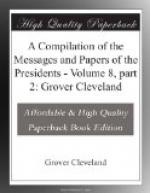The Congress of 1779 and the framers of the treaty of 1783 were therefore warranted in speaking of the northwest angle of Nova Scotia as if it were a known point. It could have been laid down with precision on any good map; it could be discovered by the use of adequate methods and the expenditure of a sufficient appropriation; it was, in fact, as well known as the forty-fifth and thirty-second parallels of latitude, which are named in the same article of the treaty, or as the boundaries of very many of the States which had united in the Confederation. These were defined by the course and sources of rivers—by parallels of latitude and circles of longitude, either of indefinite extent or setting out from some prescribed point whose position was to be determined. At the time of making these grants, as in the case before us, many of the boundaries had never been visited by civilized men. Some of these lines had, indeed, been sought and traced upon the ground in pursuance of orders from the privy council of Great Britain or the high court of chancery, and the recollection of the operation was fresh in the memory of both parties. Thus in 1750 it was ordered by the latter tribunal that the boundary on the lower counties on the Delaware (now the State of that name) and the Province of Maryland should be marked out. The boundary was an arc of a circle described around the town of Newcastle, with a given radius, and a meridian line tangent thereto. This was a far more difficult operation than to draw a meridian line from a given point, such as the source of a river. It was thought in 1763 worthy of the attention of the first assistant in the Royal Observatory at Greenwich, and the American Rittenhouse was associated with him. This operation was not only of great contemporary fame, but is still quoted in English books among the data whence we derive our knowledge of the magnitude and figure of the earth. So also the same astronomer (Mason) had but a few years before the War of Independence commenced the tracing of a parallel of latitude from the former line to the westward, thus marking the respective limits of Pennsylvania, Maryland, and Virginia. With such examples before them the framers of the treaty of 1783 were warranted in considering the northwest angle of Nova Scotia as a point sufficiently definite to be made not merely one of the landmarks of the new nation, but the corner at which the description of its boundaries should begin. It has been well remarked by one of the commentators[52] on the report of Messrs. Featherstonhaugh and Mudge that if the treaty of 1783 be a grant the grantors are bound by rule of law to mark out that corner of their own land whence the description of the grant commences. The British Government therefore ought, if it be, as it is maintained on its part, a grant, to have traced the line of highlands dividing their Provinces of Nova Scotia and Canada. Had this been done in conformity with the proclamation of 1763 and the




